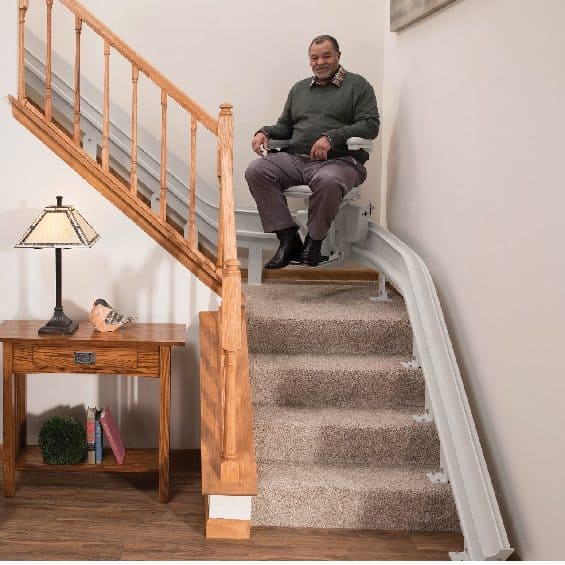When it comes to your stairlift battery, you really have nothing to worry about if you have your equipment regularly maintained and inspected. Typically, the batteries have a limited number of charges and the expected lifespan of a stairlift battery is three to five years, generally.
As long as you maintain your mobility aids, they should last. This extends to your stairlift. The battery should last around three years or more. There are some things that impact the longevity of a stairlift battery, and it is important to note that these batteries do have a limited number of charges during their lifespan. For this reason, do not switch the device off for weeks on end and have your equipment inspected annually by a mobility aid professional.
Here are some more things to talk about regarding stairlift batteries:
Keep It on the Charger
When you don’t keep the stairlift on its charge point, it significantly shortens the lifespan of the aid. Leave the stairlift on, but when it is off, make sure that it is on its charge point to preserve and maximize the lift’s life and charge. Since most stairlifts are primarily battery-powered, this is important advice.
Don’t Go It Alone
Do not try to replace your stairlift’s battery on your own. Always contact the retailer or a qualified technician to prevent damage to your equipment.
How Long Will It Last?
As mentioned, your battery should last up to five years with recommended usage, but on average, three years. But how long does a fully charged battery last in the home? You can count on approximately 20 trips up and down the stairway via a lift before the battery will require attention and charging.
Look for a Light
Most lifts have a light to indicate when it is time for service or charging. As long as you park your lift on the charge point between rides, you should be good to go. Your mobility aid technician should be able to demonstrate this feature for you at installation.
Leave It On
It is proper protocol to leave the lift on regularly. In fact, turning the lift on and off frequently is another practice that will shorten the battery life.
Have It Serviced Regularly
Pay heed to the manufacturer’s recommendations regarding service and always have your lift inspected by a mobility professional to maintain the warranty, if applicable. Your technician will test and check the charger and assess the life and voltage of your battery. The testing helps to identify when the battery requires replacement, too.
Know When It’s Low
There are some distinct signs that will point to a low battery. A low battery is something that can cause the lift to malfunction and leave you in a lurch. Remember that there are no alarms or flashing signals to let you know when the battery is running low, so keep aware of the signs that there is an issue.
Some things to watch out for include these:
- Typically, a low battery could be the reason for the stairlift to slow down. This may be just slightly slower than its normal speed, but as it becomes less charged, it will continue to slow.
- Another sign of a low-charged battery is sudden stops and halts in operation. Your lift may start okay, but then cease to move after a short distance or a few stairs. Sometimes the lift will start back up on its own.
- Another indication that the battery is very, very low is when it simply will not charge when connected to its normal parked charging point. This merits a call to a stairlift technician and likely will require a replacement battery to resume proper operation.
These signs are pointing toward the need to contact your mobility aid technician and likely are going to require the purchase of a new battery for your stairlift. As mentioned, never try to replace the battery on your own. It can be complicated and could potentially cause damage to the lift if done improperly.
Prepare for a Power Outage
Ever wondered what happens to your lift if and when the power goes out? Since stairlifts are usually battery operated with electric charging points, it probably means that your lift won’t charge during the outage. This could be a problem for prolonged periods of service interruption if you have not been charging your stairlift between uses properly. Talk to your mobility aid retail professional to learn more or for more information about purchasing a stairlift.
Got questions about your stairlift battery? Always refer to the owner’s manual and manufacturer’s recommendations for use. Call or visit Pacific Mobility, to learn more about high-quality mobility aids to improve access, autonomy, and quality of life for you or someone that you care about.
President, Husband, Father, Grandfather Graduate of UC Davis- Bio Sci Major- Go Aggies! Jeff has extensive experience in all of Pacific Mobility’s products and services, and specializes in accessibility products as well as stairlifts, ceiling lifts and custom wheel chairs. His hobbies include spending time with family, gardening, mountain biking, exercising and off road motorcycle riding.
24 years as Owner/President of Pacific Mobility Center – selling, installing, and servicing stairlifts, porch lifts, ceiling lifts, pool lifts, handicap ramping, specialty wheelchairs, scooters, power wheel chairs, and other power mobility devices
Certified Environmental Access Consultant since 2008
Licensed General Contractor since 1998
Certified Aging in Place Specialist since 2016
Board Member for Home Access Professionals
Member of Association of Members of the Accessibility Equipment Industry (AEMA)




